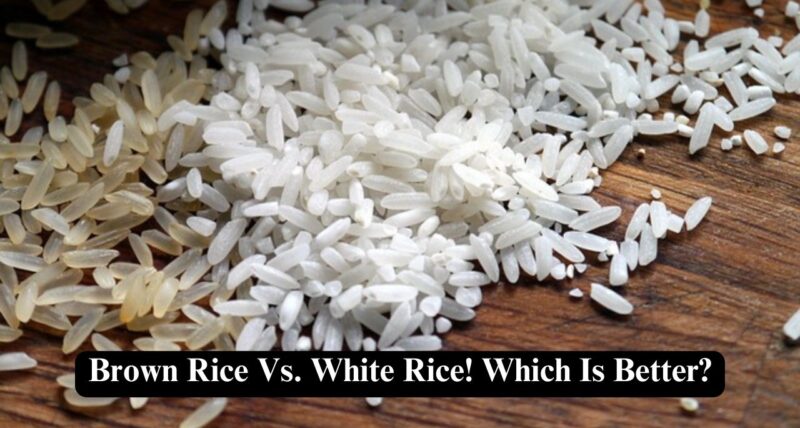Rice, a widely consumed food, is nutrient-rich. However, the diverse rice options available on the market showcase varying nutritional values. Enriched rice offers added nutrients, and grain sizes vary from long to short. Additionally, rice exists in different colors, prompting questions about the healthiest choice between brown and white rice. This comparison of brown rice vs. white rice is a common inquiry among consumers seeking the most nutritious option.
Brown rice and white rice offer distinct nutritional profiles and culinary uses. Brown rice retains its bran and germ layers, providing fiber, vitamins, minerals, and antioxidants. It promotes digestive health, aids in weight management, and reduces the risk of chronic diseases. In contrast, white rice undergoes refining. Thus resulting in a product with reduced fiber and nutrients but offering quick energy and versatility in cooking. Choosing between them hinges on factors like personal health objectives, taste preferences, and dietary requirements. Incorporating both varieties into a balanced diet ensures a diverse nutrient intake aligned with individual needs and preferences.
Brown Rice Vs. White Rice
Let’s delve into comparing brown rice with white rice:
Nutritional Composition
Brown and white rice undergo different processing methods, resulting in contrasting nutritional compositions.
1. Brown Rice
Brown rice, a whole grain, retains its fiber-rich bran and germ layers. It provides essential nutrients like B vitamins, magnesium, and manganese. With 3.5 grams of fiber per cooked cup, it aids digestion and regulates blood sugar. Brown rice also contains antioxidants, which may reduce inflammation and lower chronic disease risk.
2. White Rice
White rice undergoes milling, which removes the bran and germ layers, stripping away fiber, vitamins, minerals, and phytonutrients. It provides carbohydrates for energy. However, it lacks the nutritional richness of brown rice, with lower fiber, vitamins, and minerals and a higher glycemic index. Hence, it leads to faster blood sugar spikes.
Health Benefits
The differences in nutritional composition between brown rice and white rice translate into varying health benefits.
1. Brown Rice
Brown rice’s fiber content supports digestion. It prevents constipation and helps regulate blood sugar levels, potentially reducing the risk of type 2 diabetes. Its array of nutrients and antioxidants contribute to overall health. They lower the likelihood of chronic diseases such as heart disease, stroke, and certain cancers. Additionally, diets abundant in brown rice may help manage obesity and prevent weight gain. Therefore, it is a valuable addition to a balanced diet.
2. White Rice
White rice is deficient in fiber and nutrients compared to its brown counterpart. However, it remains a valuable source of carbohydrates and energy. Its mild flavor and softer texture make it easier to digest. It is particularly suited for individuals with sensitive stomachs or certain gastrointestinal conditions. Moreover, in many cultures, white rice holds cultural significance as a dietary staple in traditional cuisines. Additionally, its ability to provide quick energy renders it advantageous for athletes and individuals engaged in high-intensity physical activities.
Considerations
When deciding between brown rice and white rice, several factors should be taken into consideration. This includes dietary preferences, nutritional needs, and health goals.
1. Nutritional Needs
Individuals with particular dietary needs may find brown rice more beneficial. This is especially true in the case of those aiming to boost fiber intake or control blood sugar. Conversely, individuals with dietary restrictions or digestive sensitivities might prefer white rice. It has a lower fiber content, which can make it easier to digest. These considerations highlight the importance of personal health goals and dietary preferences when choosing between brown and white rice.
2. Taste And Texture
Brown rice offers a nuttier flavor and chewier texture than white rice, known for its milder taste and softer texture. Taste and texture preferences can impact the selection between the two varieties in different dishes and cuisines, influencing dietary choices.
3. Cultural And Culinary Considerations
White rice serves as a dietary staple in numerous cultures and is essential in traditional dishes. Cultural preferences and culinary traditions significantly impact the choice between brown and white rice. Both meal preparation and consumption reflect diverse culinary practices worldwide.
4. Health Goals
Individuals prioritizing overall health, weight management, or chronic disease prevention may choose whole grains like brown rice. Conversely, those seeking quick energy or requiring easily digestible options may prefer white rice in specific circumstances. Considerations like health goals and dietary needs influence rice selection.
In the brown rice vs. white rice debate, both varieties offer distinct advantages. Brown rice, as a fiber-rich whole grain, contains essential vitamins, minerals, and antioxidants, promoting digestion and reducing disease risk. Conversely, white rice primarily provides energy but lacks fiber and nutrients. When selecting between the two, factors such as taste preferences, cultural influences, and health objectives should be considered. Incorporating a variety of whole grains, including brown rice, into one’s diet fosters overall health and well-being.



